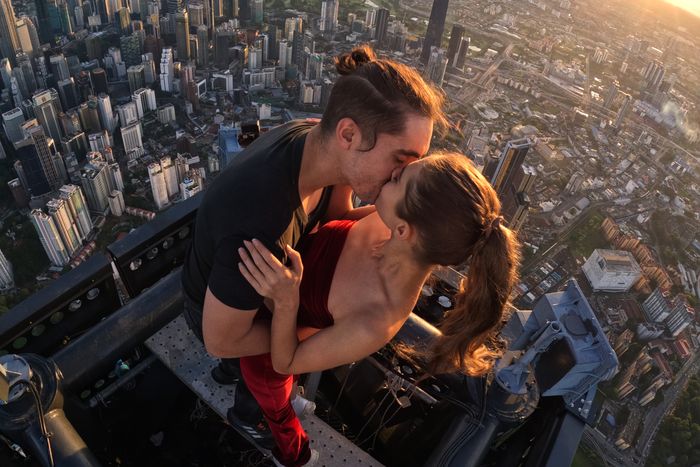
The illegal and exhilarating influencer-sport of “rooftopping” involves individuals sneaking onto giant cranes, skyscrapers, radio towers, and other tall protruding structures to crawl, climb, and sometimes traipse their way to the top to pose for pictures. It’s a mixture of free climbing and urban exploration with a dash of parkour. The Russian climber Angela Nikolau, one of the subjects of the new Netflix documentary Skywalkers: A Love Story, gained notoriety for introducing gymnastics and a softer, feminine angle to a sport that tends to valorize fitness, dominance, and adrenaline. As the film tells it, her poses — sometimes casual, sometimes intense, always impressive — caught the eye of fellow climber Ivan Beerkus, and the two soon began collaborating. The fact that they’re both strikingly good-looking might have had something to do with it, too. A romantic relationship soon ensued.
As a film, Skywalkers: A Love Story can be both muddled and predictable. It begins in typical streaming-doc fashion, in medias res, with Angela and Ivan breathlessly hiding from some workers as they attempt to scale Kuala Lumpur’s Merdeka 118 tower in 2022, while everybody down at street level is distracted by the World Cup final between France and Argentina. Then the movie flashes back to tell their overall story — from Angela’s childhood in a circus family, to their initial collaboration, to their attempts to scale greater and greater heights, always with an eye on their follower counts. Along the way, we get standard-issue moments of personal challenge. The Russian invasion of Ukraine is a disruption. COVID is a disruption. A breakup is a distraction. Their story seems genuine, but the filmmaking can make it all feel premeditated, in part because directors Jeff Zimbalist and Maria Bukhonina are determined to hit every plot turn at the most obvious points. Even that initial moment of tension atop the Merdeka tower, the second-tallest building in the world, has a weirdly fabricated quality: There’s a big bright light on Ivan’s face as he frantically hides from the workers, trying not to cough. Really? A huge bright light, shining there for all the world to see?
But maybe the light was there. These are people who record their every move and whose social currency is built on their ability to present compelling footage to their many thousands of followers. They live in a world where there’s always a camera or a phone conveniently placed nearby to capture the moment, even (maybe especially) during supposedly intimate, vulnerable ones. As a result, Skywalkers hovers between a sense of constant performance and disarming immediacy — the latter generally during the many vertigo-inducing drone shots of Ivan and Angela’s hair-raising accomplishments. The filmmakers cut freely and rapidly among the duo’s poses, their stumbles, their fears, their tightrope walks across precarious beams in the sky. The camera rarely settles.
That rooftopping became so popular in the past decade among young men and women in the former Soviet Union probably says something about a generation with nothing left to lose trying to assert their personality and power over rapidly changing and oppressive urban landscapes. Obviously, there are rooftoppers that hail from all over the planet, so perhaps young generations with nothing left to lose are a universal phenomenon nowadays. But it also just plain looks amazing when someone makes it to the top of an impossibly tall building and hangs over the edge. As someone who gets queasy simply looking at a roof gutter, I find these pictures and videos both nerve-racking and wonderful.
And so, for all its problems, Skywalkers is often very watchable. It can be hard for the viewer to take in more than a mere movement — a shame, because one imagines the heart-stopping tension that could be evoked if the movie had the patience to take in the full measure of what these people are doing. Then again, a lot of this material is probably footage that’s already been pre-edited for rapid-fire internet consumption. There’s a story there, one that perhaps speaks to the way we live now. And that’s the question that underlies much of what’s onscreen in this perplexing, entertaining, frustrating picture. You can sense the more thoughtful film lurking beneath all this footage, one that more fully explores the nexus of raw physical achievement and premeditated celebrity at which these people live.
But then, you look down.
More Movie Reviews
- The Thriller Drop Is a Perfect Addition to the Bad-First-Date Canon
- The Accountant 2 Can Not Be Taken Seriously
- Another Simple Favor Is So Fun, Until It Gets So Dumb


